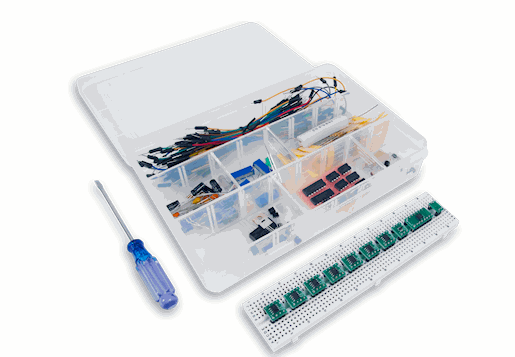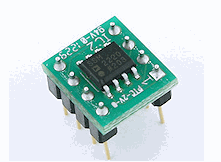Analog Parts Kit
Summary: Here's a cool kit of parts for folks who want to experiment with analog circuits.
Digilent, Inc (www.digilentinc.com) is an interesting company that specializes in creating boards and kits for educational purposes. The sell all of the usual sorts of hardware like FPGA and PSoC boards. But they don't neglect the analog part of the embedded world, and have some very interesting products in that domain.
One is the Analog Discovery, a low-cost USB scope I reviewed here: https://www.ganssle.com/tem/tem233.html. A companion product is the Analog Parts Kit (https://www.digilentinc.com/Products/Detail.cfm?NavPath=2,842,845&Prod=APK), which is exactly what you'd expect from the name. It's a box packed with all sorts of components for playing with analog circuits. Clearly they have a relationship with Analog Devices as the ICs all come from that company and Analog's logo is splashed across their web site. No problem there; I've been a fan and user of Analog's parts since just a few years after their founding in 1965.
The kit includes a wide selection of passives like resistors, capacitors, pots and inductors. The active devices cover a pretty broad range, including transistors, diodes, LEDs, op amps, voltage regulators and references. But there's also an instrumentation amp and matched transistor packages. Serious parts for serious analog work. Sensors abound, which makes it possible to build some pretty cool circuits. These include current, magnetic, vibration and temperature sensors, as well as an accelerometer and photocell.
There's also a 6.5" X 1.25" solderless breadboard with 70 jumper wires with pin ends.
 Analog Parts Kit - I lifted this pic from Digilent's web site. It does a poor job of showing the wealth of included components.
Analog Parts Kit - I lifted this pic from Digilent's web site. It does a poor job of showing the wealth of included components.
Ten of the supplied ICs are SMT devices, which would normally create all sorts of headaches for experimenters. But these are cleverly mounted on tiny little PCBs which plug directly into the prototyping board.

DIPizing an SMT part.
The Kit comes with zero documentation. For instance, we pros know what "104" means on a capacitor, but the novice will be clueless. The Kit's web page mentioned earlier does have a picture of each component, which helps. And there's a very helpful link to each part's datasheet.
The Kit is a very useful jumble of parts that is just aching for a companion booklet that leads newbies to the non-digital world through the fun landscape of analog electronics. An experienced engineer who needs parts for occasional experiments will find the Kit very useful. For $60 ($50 if purchased with the Analog Discovery scope) this is also a great deal for a parent of a youngster who wants to learn more about electronics. He will, however, need a mentor or will have to do a lot of homework to find ways to use the components.
This page (https://www.digilentinc.com/Products/Detail.cfm?NavPath=2,842,1018&Prod=ANALOG-DISCOVERY) gives a half-dozen experiments. For instance, one (https://www.digilentinc.com/Data/Products/ANALOG-DISCOVERY/Analog%20Discovery-SpeakerResonance.pdf) shows how to measure the resonance of a loudspeaker, which is a pretty cool concept as resonance is such a fundamental idea in electronics. But there's not a peep about what resonance is and why the experiment works.
The company also has over 40 videos (http://www.digilentinc.com/Classroom/RealAnalog/) explaining analog electronics with Powerpoint slides. Each has a couple of experiments, too, that use the Analog Parts Kit and the Analog Discovery. I looked at several of the videos and the slides; the courses look extremely complete. Go through them and you'll learn a tremendous amount about analog. But you'll also need to know calculus, which pegs this above the amateur level. The target market seems to be the engineering student crowd. Yet the components could get a much younger kid interested in this field.
Analog Devices has a bunch of experiments here: http://wiki.analog.com/university/courses/electronics/labs. They use a solderless breadboard but apparently not the Analog Discovery kit, as some of the activities require components not provided with the kit. At least one uses a 741 op amp! A great part in its day, but that day was long, long ago.
We had family here over Christmas. One of the children asked about the clutter of test equipment and components in my office. Using the Kit, in just a few minutes we built a sensor that flashed an LED when the temperature exceeded 75 degrees using the TMP01. Then, adding the AD654 V/F converter, a capacitor and a few resistors we had the temperature varying a square wave's frequency. That, of course, meant using a scope.
He was mesmerized.
Every engineering student needs this or something similar to get some real hands-on experience with circuits. Reading about the subject is fascinating, but building stuff is what builds great engineers.
Published December 20, 2012

